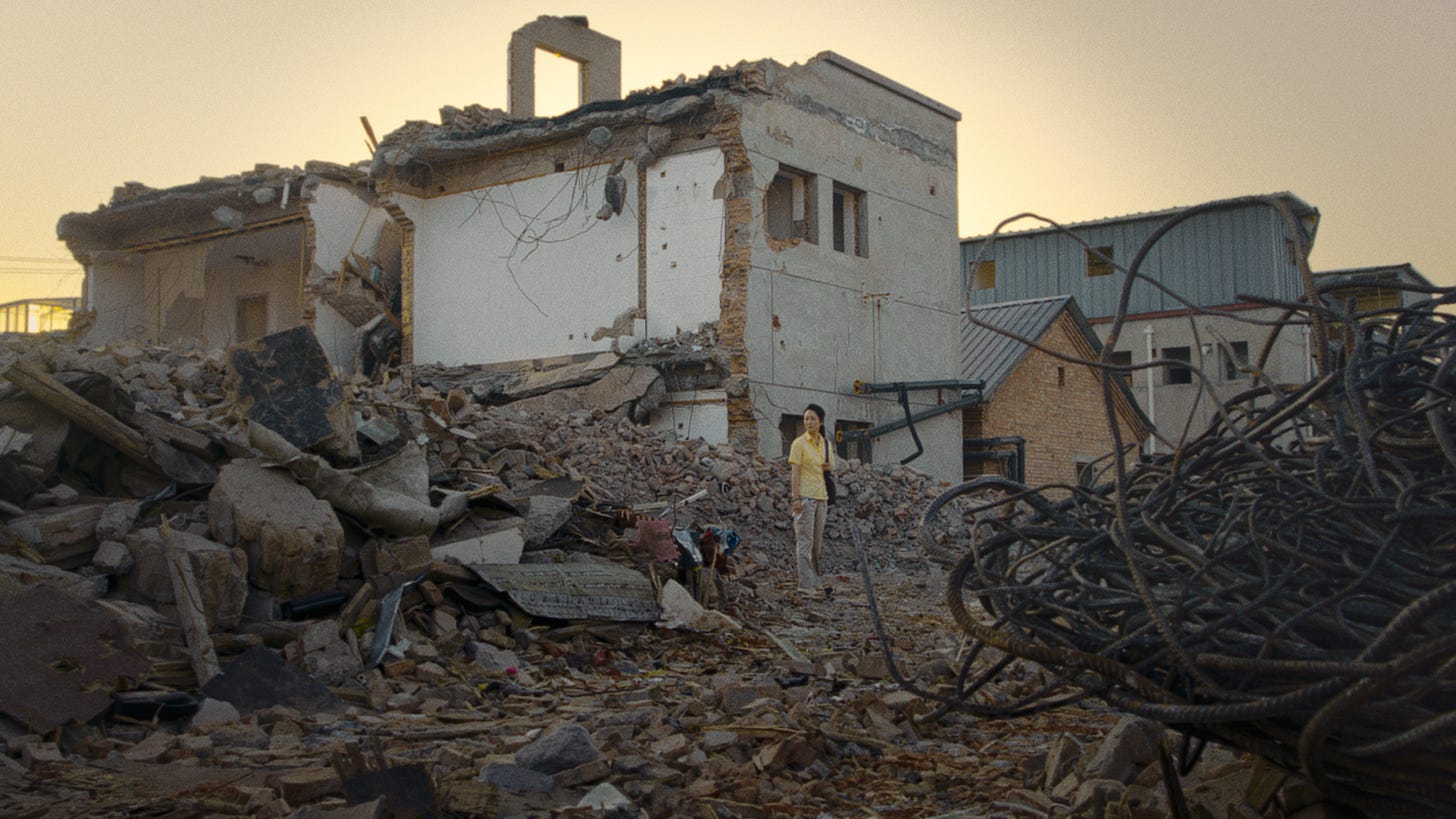During the production of 2002’s Unknown Pleasures, Jia Zhangke set out to capture a film of unknowns. Armed with a mini-DV camera, Jia wandered around DaTong, recording the eroding textures of his rapidly modernizing hometown. Disappointed with the footage (and perhaps recognizing that the project may require seeing out the country’s transformation), Jia set the film aside, and made the ambivalent poetics of Chinese urbanization his directorial subject.
Titled in Chinese as Winds of a Generation, Caught by the Tides is the result of Jia’s project from two decades prior. More than a national portrait, the film, which features a mixture of the aforementioned mini-DV footage, deleted scenes from his features, and a newly-shot post-pandemic segment, benefits from the accumulation of auteurist resonance, functioning as a generational coming-of-age film, an autobiographical romance, a career retrospective, and an elegy for a time and place swept away by the tides of change.
Structurally, Tides takes the format of Jia’s recent melodramas. Split into three sections, each set during a different time period and typified by a different era of Jia’s filmmaking, Jia stitches a loose romance out of wildly disparate elements. In 2001, Qiao Qiao (Jia’s wife and muse Zhao Tao) is a local DaTong beauty whose boyfriend, Bin (Li Zhubin), leaves town to explore financial opportunities and promises to call for her. By 2006, still waiting for her call, Qiao Qiao travels to Three Gorges to search for him. In pandemic-set 2022, the two reunite in an unrecognizable DaTong.
Given the nature of Tides’ construction, the primacy of narrative is tenuous at best, but what’s important is less the characters themselves than the way they (and their footage) ebb and flow with their surroundings, which includes not just to their globalizing environs, but also their documentary context and the rhythms of Jia’s filmmaking. This is exemplified by the opening segment, which may represent the pinnacle of Jia’s career thus far. What’s extraordinary isn’t just the expressive power of his documentary footage, which is subtly expressionist while remaining urgently immersive, but also the seamless way he incorporates narrative information within such a context. Often shot with the same handheld digital, Qiao Qiao and Bin’s scenes are nearly impossible to discern from pure documentary, to the point where the distinction is meaningless. While there’s incredibly moving present-tense eulogy in Jia’s recurring use of 360 degree pans and tracking shots that momentarily turn daily life into transient tableau, this opening movement functions as a musical of exultant harmony, one which revels in being a part of palpable national transformation. The best sequence in this vein is a montage of dance scenes. Creating a continuum between a raucous dinner party (a sly reference to similar sequences in Platform), and the celebration of Beijing’s successful Olympic bid, the seamless coordination of digital and analog, fiction and documentary, individual and collective, distills the era into pure energy, the pulsating psychedelia coalescing around the dreams of a populace looking towards a future teeming with possibility.
Of course, both history and Jia’s films have shown that the reality of monumental transformation is destructive, heartbreaking business. As Qiao Qiao finds herself in Three Gorges, her romantic disillusion stands in for a national one. Primarily made up of outtakes from Still Life, Qiao Qiao’s romantic quest turns her into a silent witness to the mass dislocation caused by the construction of the Three Gorges Dam. Filled with dystopian Antonioni-inflected images of Qiao Qiao walking through the rubble of displaced lives, this middle section benefits from a productive confusion as the landscape literally shifts around Qiao Qiao’s solitary figure. Rousing pop signifiers stand in contrast to the scale of national strife. An audio snippet from the singing competition show Super Girl (my childhood obsession from 2004-2009!) cuts to an update on the town’s rising water levels. A cutout of Mando-pop star Jay Chou sticks to an abandoned wall. Unfurled cassettes protrude from the concrete ruins.
If there’s a sense that Jia has capitulated to Chinese censorship, it lies in his choices of human documentary footage, which prominently highlights residents smiling in unity, and in one of the only interviews, a man characterizes his relocation as one for the betterment of the country. And yet, the affective power of Jia’s imagery remains a powerful statement in its own right, and the visual language, which retains some of the verisimilitude of the 2001 segment (see: an incredible documentary tracking tableau that ends with the introduction of Qiao Qiao’s character), conveys an extended lament. Both this middle section and its source material from Still Life are about the convergence of sense-making and letting go. That sentiment is mirrored in Jia’s consistent usage of dissolves and by the trajectory of Bin’s life, with its subterranean evocations of his shady business dealings. Qiao Qiao’s relationship with him is as much a lost cause as the future of his corrupt, if communally-oriented career in this molten, alien landscape.
In a meta-textual fashion, the failings of Jia’s contemporary-set footage speak to the erasure of the rural, small-town ShanXi culture that informs his best work. In an unrecognizable, fully urbanized DaTong, Qiao Qiao and Bin re-unite and bear witness to the physical effects of time. Beset by China’s intense pandemic restrictions, there’s a perversion to Jia’s depiction life in 2022, even if it’s only ambiguously intentional. Characterized by an intense, and oftentimes ugly, digital gloss, Jia’s pointed attempts at temporal signposting, which include airplane passengers scanning each other’s WeChat QR code and a silly TikTok dancer cum wedding venue advertiser, are stilted at best, recalling the clumsy didacticism that led him to name a character in Mountains May Depart “Dollar”. While there’s still strong imagery to be found, especially in a ballroom dance sequence with antiseptic cleaners spraying fumes in the background, there’s a disconnect between the diegesis and the texture of real-life that’s ultimately trying.
All of this would be less of an issue if the 2022 segment’s narrative wasn’t one of reintegration. After decades alone, Qiao Qiao, who works at a grocery store (there’s a fantastic self-referential shot with a panning surveillance camera that introduces her character) runs into Bin at the check-out line. Together, they watch an outdoor performance before Qiao Qiao joins a throng of runners, letting out a triumphant grunt as the camera cuts to a black screen set to a Cui Jian rock anthem.
There’s a built-in confusion to Qiao Qiao and Bin’s romance suddenly taking center stage, and even within those confines, Jia’s symbolism is heavy-handed (Qiao Qiao ties her relationship with Bin into a bow, Bin has a limp leg while Qiao Qiao runs with the crowd). What to make of the ending, and its vaguely nationalist implications of letting go of the past and embracing a new dawn? Censorship maneuvers be damned, it just doesn’t really work.
What this final section clarifies is that Caught by the Tides functions as a film where the narrative progression (a re-embracing of the Chinese collective) prominently diverges from its formal progression (the dissolution of documentary-narrative cohesion into digital, narrative self-enclosure). Jia’s pseudo-familial, provincial subjects have moved, the sorts of films he’s allowed to make has changed, and after spending most of the past decade plus making retrospective features, maybe he’s found a new well of courage to start looking towards the future.
Caught by the Tides is distributed by Janus/Sideshow and is playing nation-wide.








One of the most effective reviews I’ve read in a long time. The way that you focus on the small details of the timeframe of production and the camera textures speaks to the heart of the film I think better than trying to strenuously describe narrative developments ever could.